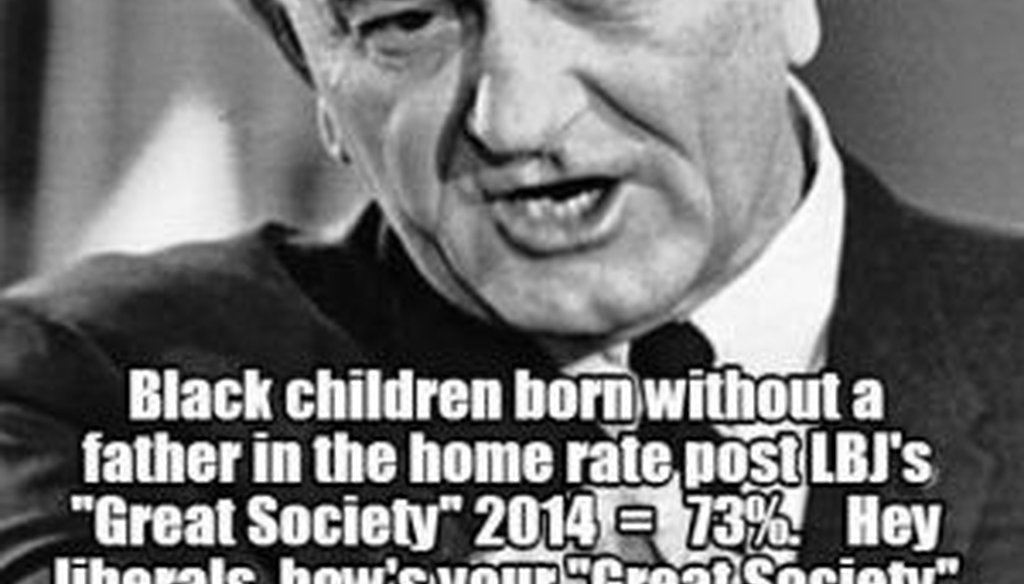Stand up for the facts!
Our only agenda is to publish the truth so you can be an informed participant in democracy.
We need your help.
I would like to contribute

A reader asked us to check this Facebook meme about rates of single motherhood, so we did.
Facebook meme blames Great Society for large rise in African-American fatherlessness
A reader recently sent us a bare-knuckled Facebook meme about race and fatherhood.
The meme features a photograph of President Lyndon B. Johnson, whose "war on poverty" agenda in the mid 1960s was known as the Great Society.
Superimposed on Johnson’s image is the following text: "Black children born without a father in the home rate pre-LBJ's 'Great Society' welfare system in 1964: 7 percent. Black children born without a father in the home rate post-LBJ's 'Great Society' 2014 = 73 percent. Hey, liberals, how's your 'Great Society' working out for the black family?"
We wanted to know if the meme’s numbers were right: Did the percentage of black children born without a father in the home rise from 7 percent before the Great Society to 73 percent today, and was it due to Johnson and the Great Society?
As we researched this claim, we noticed a problem: There is no federal data on "black children born without a father in the home." Instead, we found two types of data that are similar -- but not a perfect fit.
One is unmarried black births as a percentage of all black births. The other is the percentage of black children living without a father in the home.
The first option addresses births, a key focus of the Facebook claim. But this figure ignores cases in which a couple isn’t married, but where the father is living in the home.
The second option, by contrast, does address living arrangements, but it includes all children up to age 18, not those who were "born" that year.
So to be as complete as possible, we’ll analyze both statistics here.
Unmarried black births as a percentage of all black births
In 1964, according to federal health statistics, 24.6 percent of births to non-whites were considered "illegitimate," the term used for out-of-wedlock births at the time.
In 2012, the percentage of black births that were made to unmarried black mothers was 72 percent.
This is a large increase, and the more recent figure is more or less on target. However, the starting point in 1964 is higher than the Facebook post suggests. So the overall increase is more limited than the meme says. (Note: The 1964 figure was based on the "non-white" population, a category that includes Hispanics and Asian-Americans, while the 2012 figure was for African Americans only.)
So if you use this measurement, the meme’s numbers are off.
The percentage of black children living without a father in the home
These figures offer even less support for the Facebook claim.
According to Census Bureau data, about 20 percent of black children in 1960 were living with just a mother. The comparable figure for 2013 is 50 percent of black children living with a mother only. (The only pre-Great Society year for which data is available is 1960.)
So this measurement, too, shows an increase. But the increase is two-and-a-half times bigger, not 10 times bigger, as the meme says, and it’s up by 25 to 30 percentage points, rather than the 66 points cited in the meme.
When we checked with experts, we found additional problems of context and logic with the claim. Here are a few of them:
Black families weren’t the only group to see an increase in single motherhood over the same time period
Rates of fatherlessness for whites have always been lower than for blacks, but fatherlessness among whites still rose between 1960 and 2012. Six percent of white children lived in a single-mother household in 1960, a figure that rose to 18 percent in 2013. That’s a tripling, which was proportionately an even bigger percentage increase than what was observed for black children.
We don’t really know how common black single parenthood was prior to the Great Society
Douglas J. Besharov, a public policy professor at the University of Maryland, said the official data on black marriage from the early- to mid-20th century is unreliable. It was not uncommon, he said, for black mothers to tell survey-takers that they were separated, when in fact they had never been married, he said. The data for white women is similarly misleading, since many young white women got married as teens and divorced a few years later -- a "shotgun wedding" pattern that doesn’t suggest long-term stability for children.
This pattern would mean that the frequency of non-marital births among African-Americans may have been higher than what the early 1960s statistics officially indicated, and the white rate of non-marital births may have been artificially low.
"Welfare" -- the implicit target of the meme -- existed well before the Great Society
The welfare rules of the 1960s may have imposed a "marriage penalty" on recipients -- benefits that could be earned as a single person would disappear once a recipient got married. But such a pattern should have become evident well before the Great Society.
" ‘Welfare’ was part of the New Deal in the 1930s," said Timothy M. Smeeding, director of the Institute for Research on Poverty at the University of Wisconsin. "It was designed for widows with kids who didn’t qualify for Social Security, but it soon became a single-parent program for divorcees and later unmarried mothers."
Correlation does not equal causation
Just because rates of fatherlessness rose after Johnson and the Great Society doesn’t mean they caused the increase. Lots of other factors were at play.
Besharov said the focus on Johnson is off-base. He said that the broader social currents of 1960s "liberalization" -- more permissive sexual mores, easier divorce laws and greater financial independence due to rising rates of female employment, for instance -- did play a role in higher rates of single-motherhood for all races, but "if you define ‘the Great Society’ as the things Johnson did, then there was very little impact" on single motherhood rates.
Our ruling
A meme circulating on social media said the percentage of black children born without a father in the home has risen from 7 percent in 1964 to 73 percent today, due to changes from President Lyndon Johnson’s Great Society.
There’s no federal data to back up the meme’s specific claim, but the most applicable statistics show an increase in black fatherlessness that is more limited, and the rise might have been even more modest still if the early-1960s data had been more reliable.
In addition, the focus on Johnson and the Great Society is likely a red herring, since broader, societal factors are believed to have played a major role in rising rates of single-parenthood -- not just among blacks, but also among whites.
The exaggerated statistics, combined with an ignorance of important context, leads us to rate the claim False.
Our Sources
Facebook post, received by PolitiFact in March 2013
Statistical Abstract of the United States 1967
Statistical Abstract of the United States 1966
Centers for Disease Control and Prevention, "Births: Final Data for 2012," Dec. 30, 2013
U.S. Census Bureau, "Table CH-2: Living Arrangements of White Children Under 18 Years Old: 1960 to Present," accessed March 24, 2014
U.S. Census Bureau, "Table CH-3. Living Arrangements of Black Children Under 18 Years Old: 1960 to Present," accessed March 24, 2014
PolitiFact, "CNN's Don Lemon says more than 72 percent of African-American births are out of wedlock," July 29, 2013
Interview with Douglas J. Besharov, public policy professor at the University of Maryland, March 24, 2014
Email interview with Timothy M. Smeeding, director of the Institute for Research on Poverty at the University of Wisconsin, March 20, 2014
Email interview with Tom W. Smith, senior fellow at the National Opinion Research Center at the University of Chicago, March 24, 2014
Email interview with Douglas Massey, professor at Princeton University's Office of Population Research, March 24, 2014
Browse the Truth-O-Meter
More by Louis Jacobson
Facebook meme blames Great Society for large rise in African-American fatherlessness
Support independent fact-checking.
Become a member!
In a world of wild talk and fake news, help us stand up for the facts.






































